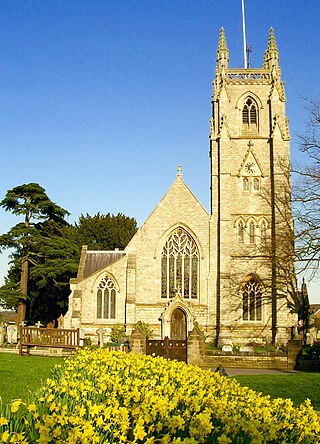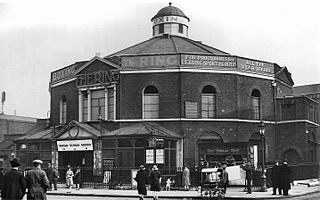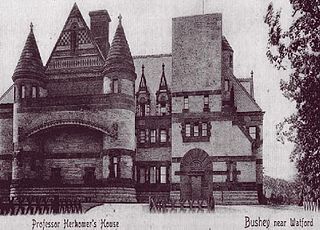
Bushey is a town in the Hertsmere borough of Hertfordshire in the East of England. It had a population of 25,328 in the 2011 census, rising to 28,416 in the 2021 census, an increase of 12.19%. This makes Bushey the second most populated town in Hertsmere. Bushey Heath is a large neighbourhood south east of Bushey on the boundary with the London Borough of Harrow reaching elevations of 165 metres (541 ft) above sea level.

Grosvenor House was one of the largest townhouses in London, home of the Grosvenor family for more than a century. Their original London residence was on Millbank, but after the family had developed their Mayfair estates, they moved to Park Lane to build a house worthy of their wealth, status and influence in the 19th century. The house gave its name to Upper Grosvenor Street and Grosvenor Square.

Hertsmere is a constituency in Hertfordshire, England, represented in the House of Commons since 2015 by Oliver Dowden, who currently serves as deputy prime minister.

Vine Street is a street in Westminster, London, running from Swallow Street, parallel to Regent Street and Piccadilly. It is now a dead end that was shortened from a longer road in the early 18th century owing to the building of Regent Street.

Coventry Street is a short street in the West End of London, connecting Piccadilly Circus to Leicester Square. Part of the street is a section of the A4, a major road through London. It is named after the politician Henry Coventry, secretary of state to Charles II.

Brockley Hill was a proposed London Underground station that was going to be built at Brockley Hill in north London as part of the 1935-1940 New Works Programme for the London Passenger Transport Board. This station would have been the first of three to be built as part of a 1930s extension project to extend the Northern Line to Bushey Heath. The next stops being Elstree South and Bushey Heath, both would have been near the Aldenham Works, London Transport's main bus overhaul depot.
Watford Rural District was a rural district in Hertfordshire from 1894 to 1974. It initially surrounded but did not include the town of Watford, which was a separate urban district. It gradually ceded territory to other districts, and by the time of its abolition in 1974 the district comprised three separate pieces of land, lying to the north-west, north-east, and south of Watford.

Northaw is a village in the Welwyn Hatfield district of Hertfordshire, England. It is part of the civil parish of Northaw and Cuffley, which was originally known as Northaw.

The Surrey Chapel (1783–1881) was an independent Methodist and Congregational church established in Blackfriars Road, Southwark, London on 8 June 1783 by the Rev. Rowland Hill. His work was continued in 1833 by the Congregational pastor Rev. James Sherman, and in 1854 by Rev. Newman Hall. The chapel's design attracted great interest, being circular in plan with a domed roof. When built it was set in open fields, but within a few years it became a new industrial area with a vast population characterised by great poverty amidst pockets of wealth. Recently the site itself has been redeveloped as an office block, and Southwark Underground Station has been built opposite.
This article provides brief details of primary schools in the borough of Watford in Hertfordshire, England, United Kingdom. Some Watford children attend schools in the neighbouring boroughs of Three Rivers and Hertsmere.
The Grange Academy is a co-educational secondary school and sixth form located in Bushey in the English county of Hertfordshire.

Lululaund was the Romanesque Revival-style house and studio of the Bavarian-born British artist Hubert von Herkomer, in Melbourne Road, Bushey, Hertfordshire. It was designed about 1886 and completed by 1894. The house was demolished in 1939.
This page provides brief details of primary schools in the borough of Hertsmere in Hertfordshire, England, United Kingdom.

Scott's Grotto in Ware, Hertfordshire, is a Grade I listed building and with six chambers the most extensive shell grotto in the United Kingdom. "It is, although on a small scale, far more complex than Alexander Pope's at Twickenham. Compared with the grotto at Stourhead, on the other hand, it is minute, but that only enhances the enchantment." The surrounding gardens and structures are Grade II* listed.
Bushey Studios was a British film studio located in Melbourne Road, Bushey, Hertfordshire which operated between 1913 and 1985. The studios were built by the film enthusiast Hubert von Herkomer in the grounds of his country house, Lululaund. They gradually took on a more professional air and in 1915 they were acquired by the British Actors Film Company for use as their principal production base. After the company ran into problems, the studio was closed during much of the 1920s. During the 1930s film boom, it was re-opened and used to produce a number of quota quickies.

The Winchester is a public house in Highgate, London. It was built in 1881 as the Winchester Tavern, and later became the Winchester Hall Hotel. The name derives from Winchester Hall, a nearby late 17th-century mansion. The pub has featured on the Campaign for Real Ale's National Inventory of Historic Pub Interiors.

The Alexandra was a pub at 133 East Barnet Road, New Barnet, London, dating from the mid nineteenth century. It was on the corner with Victoria Road. The pub was demolished in 2015 and replaced with housing.

The Laurie Arms is a pub at 238 Shepherd's Bush Road, Hammersmith, London. It was next door to the Hammersmith Palais, a long running dance hall and music venue from 1919, which hosted The Beatles, The Rolling Stones, The Who, David Bowie and the Sex Pistols, but was demolished in 2013.
St Peter's Church was a Church of England church on Upton Lane in the Upton Cross area of Newham, East London. Its origins were in a mission of St Mary's Church, Plaistow on Pelly Road, holding services in a barn then in an iron church. Joseph Lister's former home Upton House was bought by the bishop of St Albans in 1885, becoming the vicarage, whilst its garden provided the site for a permanent church, built in 1893 and given a separate parish the following year using parts of those of All Saints, St Mary's, Emmanuel and St Stephen's. The parish was merged into that of Emmanuel in 1962 - the church was left standing as a chapel of ease to Emmanuel, but its vicarage was demolished, the site being sold in 1968. Funds from that sale and the sale of the parish hall were intended for a new church, church hall and clergy house, but in 1972 St Peter's Church was declared redundant, demolished and its site sold off, leading to the scheme's abandonment three years later.

Leman Street, once known as Lemon Street, is a street in Tower Hamlets. It was built in the seventeenth century as part of the development of Goodman's Fields. It is named after John Leman who was responsible for this development, which also included Ayliff Street, Mansell Street, and Prescot Street.














